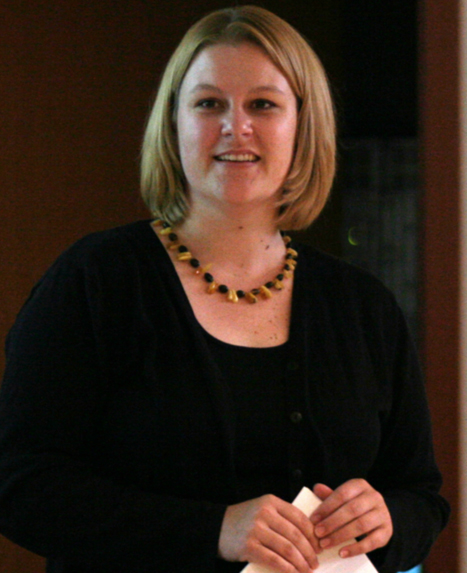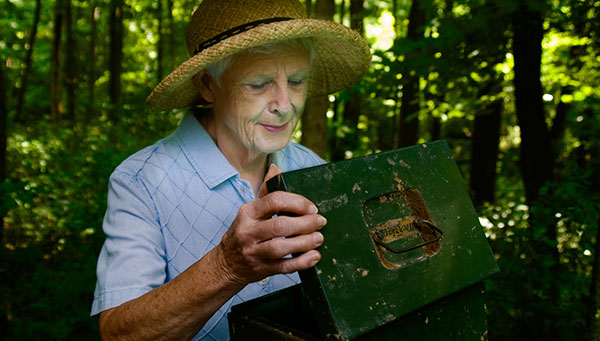 The California-born photographer came to Indiana with a love for stories and "an open eye to see the magic in a place."
The California-born photographer came to Indiana with a love for stories and "an open eye to see the magic in a place."
Bio-ethicists call it "the rule of rescue"—that powerful human impulse to help another whose life is in peril, regardless of the cost.
Last spring, Visiting Assistant Professor of Art Kristen Wilkins followed that impulse into the chilled, churning waters of the Wabash River to save a stranger. A former competitive swimmer and lifeguard, Wilkins, with her partner, Jaysen Harris, risked her life to save a 21-year-old fisherman from Lafayette.
"The river was really rushing, deep and cold," Wilkins says, "It felt like there were down currents, which really surprised me."
Wilkins and Harris kept Mark Weineke afloat and breathing for 15 minutes until emergency workers could take over.
Not a typical day for an artist.
But when you see the work Wilkins created during her year at Wabash—particularly the stunning photographs and video in her exhibit "Time is Eternity," which opens in the Eric Dean Gallery of the College’s Fine Arts Center October 27—her heroics are less surprising. The rule of rescue drives her art. In color prints evoking detailed child-like memories fading in and out of focus, or scenes conjuring characters from overlooked Indiana writers, her work seems inspired by a heightened awareness of time’s power to obliterate set against the artist’s own yearning to find something in each us of that endures.
That search brought her 2,000 miles from her native California to Indiana, where she has captured members of the Wabash community and places throughout the state on video in intriguing, often moving, ways.
One Wabash professor said it best after viewing a scene from the video that featured his Wabash colleagues: "I hadn’t realized this before—they’re beautiful."
Homesick
"My work has run along the same theme for a long time: family, connections to home, connecting to place," Wilkins says. Her own family was anything but the California stereotype.
"We all lived within a few blocks of each other. Mom and Dad would go out for dinner, and we’d go to one of the grandmothers' houses."
She earned her B.A. in biology and art at University of California at Santa Cruz in 2000. Pursuing her M.F.A. at California State University-Fullerton led to "Water Stories," a performance art piece
"I alternated four dark stories from my life with four lighter ones—like the time I almost drowned as a kid, then a story of feeling pride in myself for swimming to an offshore island." She also told of her work as a lifeguard, and the day a child had died on the deck of the pool where she was working.
Her paternal grandmother died as Wilkins was finishing grad school. Wilkins inherited her house.
"We were very close," Wilkins says. "This was the house my father grew up in, and I started to think of the house as family."
While living there she created "Autoportraits," an exhibit in which she’d digitized her own face onto a series of antique photographs. "The incentive to preserve our identities is strong, yet somehow it is still lost with time," she wrote. "Some images manage to survive as icons. Everyone wants to be significant, remembered. [In this series] I want to be an icon, to be immortal."
For her next show, she digitally altered a series of found photographs, erasing the faces and leaving only the artifacts that might be found long after the people photographed were dead. "Their faces are blank and reveal oblivion," Wilkins wrote of the images in her exhibit "The Presence of Absence." "Only my projected memories of who they might have been for me can carry them forward.
Wilkins lived in the house she inherited for three years before receiving a job offer from Wabash in 2007. Taking the job, she had to sell the home, and moving from her family home in coastal California to a rental house in small town Indiana was a shock. Wilkins coped by creating an artistic experiment. Every event was fair game. She began writing a weblog—"Here2Indiana: A Blog Performance of Cross-Continental Adaptation."
And she finished Rapt in the Nameless Reverie, one of the collections featured in her Wabash show. Many seem taken from the perspective and focus of a young child; they entice you to stop and remember.
"I was making a transition, and the photos in this exhibit are about thinking of the past, which has a lot to do with daydreaming," Wilkins says of the 18 c-prints, seven photographed in California, eleven taken here. "What does it mean for a woman, born and raised in California, to move to Indiana? What if I was to live here the rest of my life? What would I need emotionally, mentally, to feel like I was tied here?"
To answer that question, she photographed "scenes that cause me to feel enraptured, nostalgic, and reverie.
"The word ‘nostalgia’ was a medical term for a longing for home that is so great as to cause sickness or death," Wilkins says. "Nostalgia doesn’t only refer to a longing for a certain place, but a certain time; it is a sickness we can never recover from except within our dreams."
Hoping to create "a more playful piece" after her move, Wilkins made "The Distinction Between Being Grounded and Airborne," an animated film opening at the KY7 Biennial in Lexington, Kentucky this week.
"This house in Indiana was the first I’d lived in that had a basement," she explains. "We kept falling down these stairs, and it reminded me of my mom’s grandmother, who had died falling down stairs. One of her children was so horrified that she sold the house with everything in it, so my mother wasn’t able to get anything out of that house to remind her of this woman who meant so much to her.
"My own falling reminded me of this sad family history. The basement is like a metaphor for death. This piece says, yes, I know the basement will get me, but today I’m choosing to live in the moment."
All Good Things Will Come
If Reverie focuses on what Wilkins left behind, All Good Things Will Come to You Soon is her discovery of "magic" in places many native Hoosiers haven’t taken the time to find.
 The centerpiece of Wilkins’s show is housed in a 14-foot tall "barn" in the center of the Eric Dean Gallery. Inside you sit in an antique chair to watch a 45-minute video inspired by oft-overlooked Indiana authors Jessamyn West and Gene Stratton-Porter. The artist calls the video "the hardest work I’ve ever done, and, I hope, the strongest. So much more went into it on so many levels. I really pushed myself past what I’m comfortable doing."
The centerpiece of Wilkins’s show is housed in a 14-foot tall "barn" in the center of the Eric Dean Gallery. Inside you sit in an antique chair to watch a 45-minute video inspired by oft-overlooked Indiana authors Jessamyn West and Gene Stratton-Porter. The artist calls the video "the hardest work I’ve ever done, and, I hope, the strongest. So much more went into it on so many levels. I really pushed myself past what I’m comfortable doing."
Assisted by Wabash interns Matt Goodrich and Anthony Morton, Wilkins assembled a cast from the Crawfordsville and Wabash community. Among the actors were Professor Emeritus Dick Strawn, former library acquisitions manager Barb Easterling, IT specialist Macie Rudoff, and Samantha Amidon, daughter of public affairs director Jim Amidon ’87.
During the hottest five weeks of the summer, they brought Wilkins’s storyboard to life in the Caleb Mills House at Wabash, the middle of a cornfield in Montgomery County, a one-room schoolhouse in Mecca, IN, and at Shades State Park, which has become a refuge for Wilkins.
"I was so surprised to see a landscape like Shades. Then there’s Pine Hills [Nature Preserve], this ancient forest made up of trees you normally find 1,000 miles north. You find a huge rock in the middle of a cornfield, left there by a glacier. All these huge things were pushed here.
"And the Crawfordsville area is the only place you can find the ‘heads’ of crinoids," she adds. "You have to have an open eye to see the magic in a place, and if you find it, you want to grab on to that."
Wilkins was heartened by the way her interns and the cast invested themselves in the project. Morton served as cameraman, Goodrich coached his fellow actors, and both had their suggestions for how they might film and act out the story. Eileen Bowen even came up with a vintage version of "On the Banks of the Wabash" that proved perfect for her scene.
"Such collaboration was the part of the project I was least familiar with, and it was so rewarding," Wilkins says.
Her interpretation of the magic she found in Indiana is best summed up in one vignette in All Good Things Will Come to You Soon. Based on Jessamyn West’s short story "The Piano Tuner," the scene features Bowen as a middle-aged teacher in a one-room schoolhouse.
"She has given up on being a teacher, she’s forgotten her dreams," Wilkins says. "She’s isolated, and though she’s a musician, she hasn’t picked up the violin in years."
Her eye is drawn to something fluttering in a jar by the window, and when the teacher examines it more closely, sees a butterfly inside.
"She walks over and picks up the violin," Wilkins says. "Perhaps this is the moment she remembers her dreams and she realizes she can express them in this song, passing those dreams along to the kids.
"You want to feel connected to a place, like your life has a purpose. And in this piece even the children see that it’s possible to lose that purpose, then find it again."
In Kristen Wilkins’s All Good Things Will Come to You, you sense the same could be true of home.
"There’s not a scene in this piece that’s autobiographical, but that doesn’t mean the whole piece isn’t an autobiography," Wilkins says. In creating her video and literally immersing herself in the land and people of Indiana, she affirms that, as Hoosier author Susan Neville writes, "Every place on earth is filled with stories, with layers of forgotten history.
"To excavate those layers and include them in one human story; to deny invisibility," is the artist’s work.
In the art of rescue, there’s no telling whose life you might save.
Click here for a photo album "behind the scenes" videotaping All Good Things Will Come to You.